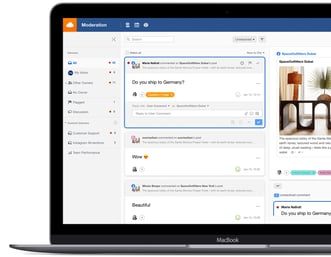If the past decade of the Internet has taught us anything, it’s that Nicholas Cage is in everything, literal rats can become celebrities if they work hard enough, and that everyone has something to say – and they want to say it loudly.
Social media has become the soapbox pedestal of choice for shouting anything and everything at the rest of the world, whether it's an opinion on the latest flavor of Oreo or whether to stage an insurrection.
Unfortunately, as a business managing social media pages for increased community engagement, brand awareness, or customer service purposes, wading into a daily melee of misinformation and profanity-laden service complaints can at times feel like waking up to do battle.
We’ve all seen the comments under the social media posts we scroll through every day – the derisive words created by faceless profiles hidden safely behind screens, emboldened to volatility with no fear of repercussions. After all, the customer is always right, and they know you are required to keep your cool and provide the best service you can no matter what they say.
Despite how much we might all like to, you obviously can’t scream at your customers on social media. You shouldn’t scream at them anywhere, but the last place you want to do that is in an open forum where words can spread like wildfire and scandals erupt in seconds.
This all goes without saying, and hopefully, these are not occurrences that your social media managers face every single day. But when customers or followers start to get out of hand, how do we best manage to keep our customer service demeanor when the enemy is at the gates and our inboxes are full of outrageous tickets? How do we make sure that we ensure quality service every single time despite the frustrations?
We’ve got you covered.
Let’s establish some vocabulary. For the purposes of this piece, and for the sake of optimism, we’ll refer to your social media followers as customers, since as a customer service worker handling social media, you’ll be managing the entire community regardless of their point in the sales funnel.

Whether they choose to do so privately or publicly, customers and others on social media are likely to make use of your pages for direct or indirect communications, including vehement complaints, tired questions, and on occasion, downright trolling.
Luckily, and we say that lightly, most people you deal with on a day-to-day basis will fall into one of the first two categories.
Most people are amenable and are just looking for tactful customer service that seems to care about the problems they’re having, and actively works to solve them in a timely manner.
The customer is not your enemy
First and foremost, stop thinking of your followers as the enemy at the gates! If you view them as a foe or a nuisance, you’ll struggle to be objective and impartial. And it’s not really a great way to think of a customer, or anyone, right?
Try putting yourself in their shoes. Perhaps they simply don’t fully understand your product or didn’t follow your directions and are now accusing your company of providing a defective product. Telling people to try turning it off and on again gets old, but that's often all they need.
On the other hand, we know that there are still some folks out there who are little more than trolls. So, how can we better handle those ones?
Equal division of labor
Depending on your social media management structure, you may be able to leverage your team to create a well-balanced and optimized workflow that limits any one person's exposure to overly frustrating situations. This is simply good workplace planning.
Did you know that you can use Facelift team arrangements to guarantee that your team is managed in a way that is more efficient and agile than ever before? You know your team members’ strengths, and with Facelift, you can assign tasks and balance your group efforts to reduce the stress on any one person while maintaining a highly effective workflow.
Hopefully this never happens, but when your employees are frayed around the edges, this can reflect back at the customer, and nowhere is this more likely to happen than on the already emotionally charged social media platforms you use.
Try not to take things personally
A universal and unfortunate truth of customer service is that as often as not, the customer is upset about something, and you’re an inconvenient hurdle standing between them and their satisfaction. Whether it’s a defective product, an unwanted gift return, or simply a question about proper product usage, you or your team probably aren't at fault, but you’re the antagonists in this story.

If your team members begin to feel attacked and frustrated, before acting directly, try quickly writing a dummy reply somewhere other than in your actual social media response boxes, or the Facelift moderation tabs.
Take out a Word document, or notepad, and write your response so as to avoid any potential accidents involving emotionally charged responses. In your personal document, you can swear, rant, curse, and just get out all your frustrations somewhere where you're not at risk of accidentally pressing "enter". Use this space to craft a well-written response without risk.
Take full advantage of your moderation features
Social media sites always come with built-in moderation tools that you can use to ensure that your audience behaves. Angry customers, unfortunately, can take their aggressions out publicly, and this isn’t a great look for your team or your product.
It’s also not a great look to build a reputation for banning or blocking your fans or customers. This quickly appears as though you cannot take criticism and are being disrespectful. Some platforms, such as Facebook, come with a mute comment option in which only your administrators and the person leaving the comments can see the post. This effectively blocks negative content from your page, it doesn’t alienate others, and conversations can be had with the muted individuals more privately.
If all else fails, ask those with negative comments to send you a private message for more direct support.
Facelift’s Moderation panel even allows your customer service team to indicate whether they’ve had a positive or negative interaction with an individual, for future reference.
Escalate
Sometimes, the best thing to do is to take a step back and think about the best way to proceed in a way that provides optimal service. Just like any other customer service call or ticket from other sources, social media services can be handled the same way. But how?
First, it’s important that messages do not go unread or unresponsive for very long on any channel, and evidence suggests that more than 40% of users expect to receive a reply on social media for customer service purposes within an hour, and 85% expect one within 6 hours. Another study even shows that as many as 60% expect a response within one hour! 
That sounds rough, and it could be in some circumstances, but it is also something to be taken advantage of.
Prompt replies are a hallmark of quality customer service, but don’t forget that unlike chat services or phone calls, you do in fact have time to relax and formulate a decent response. An hour is an extraordinary amount of time.
To gain yourself some time, don’t just ignore your customers. Politely state that you will escalate their inquiries to the appropriate authority and get back to them as soon as possible, even if it’s not entirely true and you’re just buying yourself some time. This has the added benefit of making a cranky customer feel like special attention is being paid to their concerns, may give them a chance to relax, and is a great way to get them back on your side.
Conclusion
The same study that we linked to above also states that 88% of social media users engaging with a brand for customer service purposes are three times more likely to recommend your product or brand if they have a positive customer service experience.
Keeping your cool when all you want to do is explode at ignorant, irritable, or downright mean customers and social media followers isn’t always an easy task – and the Internet can at times be even more brutal than your average phone service complaints.
You can enhance your customer service team’s workload and peace of mind with some of Facelift’s moderation features. Not only does Facelift provide a convenient inbox for managing all your social media messages and comments, across all platforms, in one place, it also gives you a great amount of control.
With Facelift’s Moderation, you can segment, assign and label social media correspondence with ease, taking weight off of the shoulders of your hard-working customer service team.
Take advantage of the resources at your fingertips to ensure that you or your customer service team are not becoming overwhelmed by social media activities.
Try out some of these ideas, and hopefully get back to pleasantly asking your followers:
"Have you tried turning if off and on again?"
Speaking of resources, we’ve devised a handy daily checklist for moderating your social media pages effectively. Download it for free right here.










